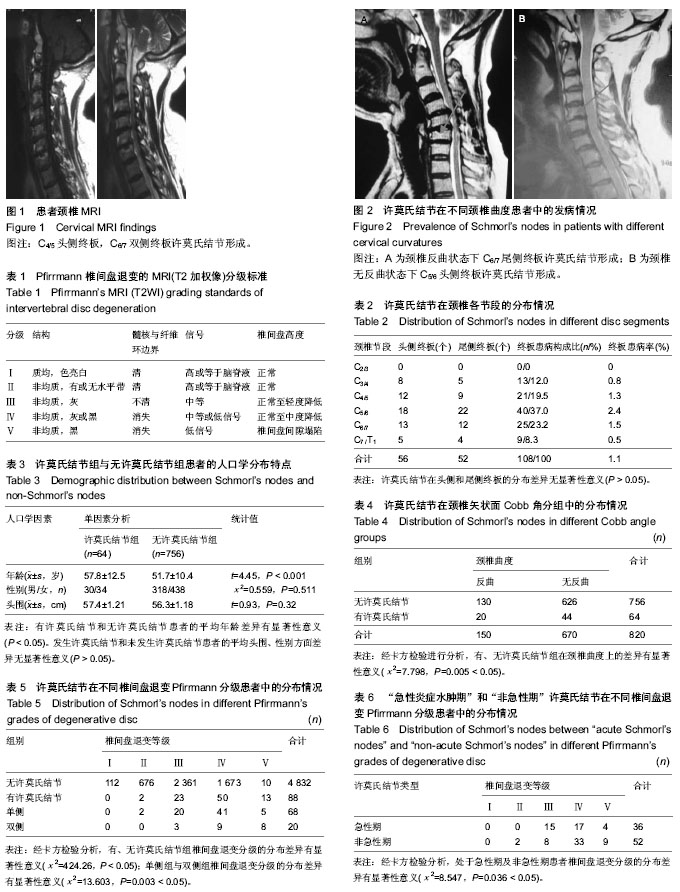中国组织工程研究 ›› 2014, Vol. 18 ›› Issue (48): 7867-7872.doi: 10.3969/j.issn.2095-4344.2014.48.028
• 骨与关节临床实践 clinical practice of the bone and joint • 上一篇
颈椎节段中许莫氏结节患病率及分布特点与椎间盘退变的相互关系
曹 胜1,2,张学利2,胡 炜2,朱如森2,万 军2,刘 岩2
- 1天津医科大学研究生院,天津市 300070;2天津市人民医院脊柱一科,天津市 300121
Prevalence and distribution of Schmorl’s nodes in cervical segment and its relationship with intervertebral disc degeneration
Cao Sheng1, 2, Zhang Xue-li2, Hu Wei2, Zhu Ru-sen2, Wan Jun2, Liu Yan2
- 1Graduate School of Tianjin Medical University, Tianjin 300070, China; 2First Department of Spine, Tianjin People’s Hospital, Tianjin 300121, China
摘要:
背景:关于许莫氏结节的相关性研究多见于腰椎节段,其在颈椎节段中的分布规律以及相关因素研究较少。 目的:探讨许莫氏结节在颈肩痛患者中的分布特点,并分析许莫氏结节发生的相关因素。 方法:选择2012年1至12月因颈肩痛行颈椎MR检查的患者,共820例,其中男398例,女422例;年龄30-80 岁,平均(52.2±11.5)岁。统计许莫氏结节在颈椎节段、年龄、性别、头围、颈椎曲度、颈椎间盘退变分级中的分布特点,分析上述因素与其发生的相关性。 结果与结论:820例患者4 920个颈椎节段中,64例(7.8%) 88个椎间盘(1.8%)临近终板(108个,1.1%)发生许莫氏结节,头侧与尾侧终板许莫氏结节的发生率之间的差异无显著性意义(χ2=1.471,P=0.689 > 0.05)。终板患病率以C5/6(2.4%)最高,其次为C6/7(1.5%)和C4/5(1.3%)。许莫氏结节的发生与年龄、颈椎曲度、椎间盘退变有明显的相关性(P < 0.05),但与性别、头围无关(P > 0.05)。邻近终板存在和不存在许莫氏结节的椎间盘在椎间盘退变分级的分布差异有显著性意义(χ2=424.26,P < 0.05),前者间盘退变更严重(Z=58.80, P < 0.05)。双侧终板与单侧终板发生许莫氏结节的椎间盘在椎间盘退变分级中的分布差异有显著性意义 (χ2=13.603,P=0.003 < 0.05),前者间盘退变更严重(Z=3.44,P < 0.05)。邻近终板发生“急性期”和发生“非急性”期结节的椎间盘在椎间盘退变分级中的分布差异有显著性意义(χ2=8.547,P=0.036 < 0.05),后者间盘退变更严重(Z=2.40,P < 0.05)。将影响许莫氏结节发生的相关因素进行spearman秩相关分析,发现椎间盘退变程度与许莫氏结节发生的相关性最强,年龄次之,颈椎曲度最弱。提示在颈肩痛患者中,许莫氏结节好发于C5/6节段,头侧与尾侧终板许莫氏结节的发生率差异无显著性意义;许莫氏结节与年龄、颈椎曲度、椎间盘退变分级存在相关性,且与椎间盘退变分级相关性最强。
中图分类号:

.jpg)